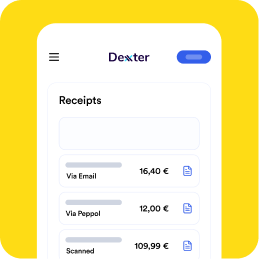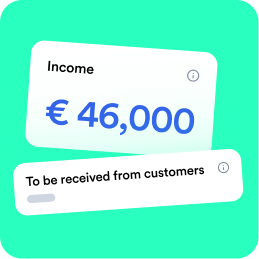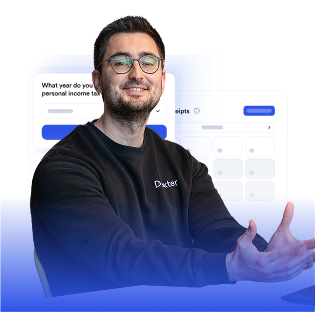Are you considering working in a secondary occupation on top of your permanent job? Or are you already self-employed in a secondary occupation, but are you wondering how many hours you are allowed to work, and what is your maximum income? As well as what role expenses, social security contributions and taxes play? Dexxter gives you the crystal clear answer.
There is no limit to your income as a self-employed person in a secondary occupation
Let us immediately kill a persistent rumor: there is no income ceiling for the self-employed in secondary occupation! You can earn as much as you want and as much as you can with your self-employed activity in secondary occupation. This has no impact whatsoever on your employee status!
Your turnover as a self-employed person in secondary occupation can be as high as you want, your expenses can be as high as you want and, consequently, your profit (turnover – expenses) can also be as high as you want.
Even if your self-employed activity in a secondary occupation would generate more than your employee status, that has no impact on your employee status. Your self-employed activity as a secondary occupation will still remain your secondary occupation.
Likewise for the number of hours you work as a self-employed person in a secondary occupation, that has no impact whatsoever on your employee status. Even if you perform many more hours in a secondary occupation than you do as an employee, your employee status will still remain your main occupation, provided you meet the conditions!
Self-employed in a secondary occupation: conditions
Being self-employed in a secondary occupation is determined solely by your activity as an employee (which is then, in theory, your main occupation). What you do in a secondary occupation, how much you earn, how many hours you spend doing it,… none of this matters!
Your self-employed activity is automatically a secondary occupation if, in addition to your self-employed activity, you are also working as a salaried employee for an employer:
- In the private sector, you must perform at least half the number of hours of a full-time contract. Just how many hours that is can be looked up in the collective bargaining agreement (CBA) that is in place for your company. If there is no collective bargaining agreement, look to the joint committee for your sector.
- In the public sector, you work at least half the working hours of a full-time position. A full-time position runs for at least 8 months or 200 days per year. In the public sector, you may also need permission from your employer. So it is best to check with your employer to make sure everything is in order.
- If you work in education and have a permanent appointment, you work at least 6/10 of a full-time schedule. If on contract, you work at least half-time (at least 5/10 of a full-time schedule).
Thus, the above conditions determine whether your employee status is your main occupation. If this turns out to be the case, your self-employed activity is automatically your secondary occupation.
Self-employment in a secondary occupation: advantages
On the one hand, you obviously have the advantages of an extra income, you keep your social security cover as an employee, you can contribute expenses via your self-employed activity, and so on.
On the other hand, you also need to think about the impact of a self-employed activity in a secondary occupation on your taxes, and here we are talking specifically about social security contributions & personal income tax.
We have written two convenient courses, namely the crash course for entrepreneurs exempted from VAT and the crash course for entrepreneurs subject to VAT.
In these crash courses, we also zoom in on concepts such as “social security contributions” & “personal income tax” and how they are calculated.
At least know that as a self-employed person in a secondary occupation, you have to pay 20.5% of your profits in social security contributions. That rate is just the same as for self-employed persons in main occupation, this group also pays 20.5% of their profits in social security contributions.
So it is not the case that self-employment in a secondary occupation will cause you to pay less social security contributions than a self-employed person in a main occupation. This is a persistent but unfortunately erroneous myth. The rate for social security contributions as a self-employed person in a secondary occupation is also 20.5% of your profits, just as it is for someone with a self-employed activity in a main occupation.
Dexxter to the rescue
Luckily, you can rely on Dexxter to calculate everything up-to-date for you. You simply enter your purchase and sales invoices in the accounting software and Dexxter does all the rest. We show you the impact on your personal income tax, no surprises there!
Likewise for social security contributions: Dexxter automatically calculates the profit of your self-employment. This way we can also show you in real time how much social security contributions you must pay, how much you have already paid and how much you still have to pay (or can recover).
Would you like to discover Dexxter?
No problem with Dexxter. You can always use our 30-day free trial. This gives you enough time to discover all our features, including the VAT listing module.
Do you still have specific questions? That’s perfectly normal, so do many of your colleagues, by the way!
That’s exactly why we also built a community in Dexxter. That’s a place in the app where entrepreneurs can ask questions and get answers from other entrepreneurs. Brainstorming together, in other words, to come up with solutions.
You will also get access to our learning center on Dexxter, full of content, videos, courses, and more.
You are not alone as a (starting) self-employed person, let that be clear!















